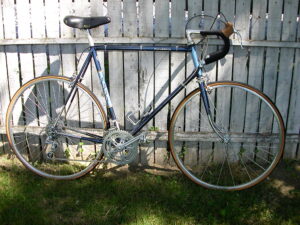This is actually about bicycles, not the metric system. I’m not going to drone on about my position that we should just all say, “fuck it,” and start using the metric system exclusively and damn the retrograde cavemen all to hell if they can’t keep up.
My dad and I shared a love for sports cars. We used to have many books on them, talked about them a lot, and went to car shows to gawk at them. Despite that, as I moved into my high school years, I had little or no desire to learn to drive a car. (When I finally learned to drive, it was on a 1963 Porsche 356B. Take that, mudanes!)
I had read somewhere that the bicycle was the single most efficient machine for converting human energy into motion, and considering how tiring it was to ride my AMF Huffy 10-Speed to school, I had my doubts, but then I learned that there were differences in the quality of bikes. I convinced my dad to take me to a large bike store in Tucson.
After a good hour or so of talking with the “bike guy” at the shop, I convinced my dad to buy me a Centurian Super LeMans, a decent starter roadbike.
I never rode it to school because I was afraid of bike theft, but if the days were long enough (and it didn’t conflict with Star Trek reruns), I’d always get in an hour’s ride after school and several hours on weekends and school holidays.
There were no satnavs to measure distance in those days. You either installed an odometer on your bike, which reduced efficiency, or you worked it out on a map. I soon wanted to know how far I was riding, so I began to come home from my rides, measure them on the map, and then log them.

In my first full year, I hit almost 8,000 miles or about an average of 21 miles a day. This was actually enough to convince my dad that riding bicycles wasn’t just a passing fad for me, so he helped me buy a newer, better touring bike. My new bicycle was a beautiful blue, hand-detailed Fuji America, which was still manufactured in Japan in those days. It was a dream to ride, and an absolutely perfect frame size and geometry fit for me. It immediately increased my average speed with the same amount of work, increasing my daily distance.
And then I got a crazy idea. If I can do 8,000 miles in a year without really trying on a lesser bike, why not set my sights on an even 12,000 miles per year? (I picked that number because 1,000/month appealed to my sense of aesthetics and nothing more.)
I wasn’t in training for anything. I didn’t have any goals or ambitions. I just really enjoyed being alone with my thoughts on the road. I hit my numbers, but it was tough, and it had its toll on me. I couldn’t get enough miles on weekdays, so I had to make it up on the weekends. I would frequently be out all day, and summer temperatures in Tucson were no picnic, even back in the 80s. Sometimes, I’d have to make up a month’s shortfall in the next month… or even the next.
Even after a year of it, I would come home absolutely exhausted. I drank a lot of Gatorade. I hate Gatorade now.
As I’ve gotten older, I’ve noticed the parts of me wearing out first are my knees and my neck, consistent with where the strain was riding my bike back then.
If I had been using the metric system all along, that first year would have been roughly 12,500 km (because I was using a map to estimate). I wouldn’t have decided I needed to hit a higher goal, and if I did, it probably would have been an aesthetically pleasing 15,000 km, or only 78% of what I actually did.
I regret not switching to the Metric System earlier. The Metric System saves knees.
My knees hurt just thinking about this.